The best varieties of edible honeysuckle for Belarus
Several centuries ago, honeysuckle was considered exclusively an ornamental shrub: it was believed that its fruits were poisonous. Now the culture is found on the personal plots of not only Russian, but also Belarusian gardeners. It is unpretentious in cultivation and ripens earlier than other crops: the first fruits are harvested already at the beginning of summer. The rich vitamin composition of the berries allows them to be used in folk medicine, and their sweet pulp with a tart aftertaste allows them to be used in cooking.
Let's consider the popular edible varieties of honeysuckle in Belarus, the features of their planting and care.
Requirements for choosing a honeysuckle variety for Belarus
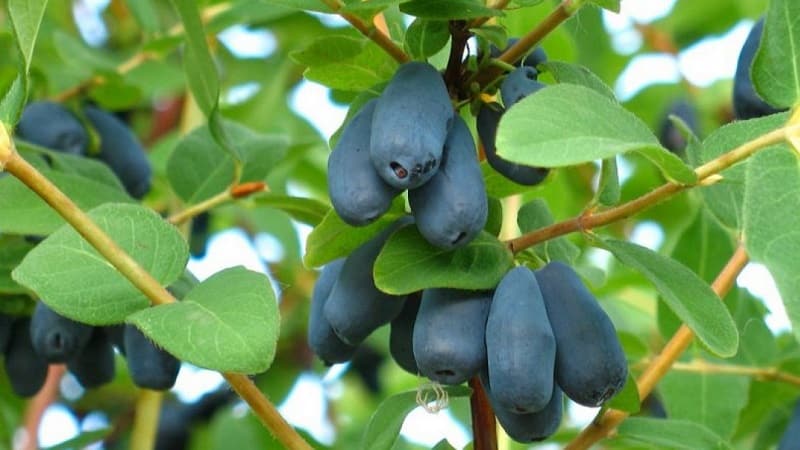
For Belarus, they choose varieties that are easy to care for and have strong immunity. Otherwise, honeysuckle will often get sick and show low yield. If the crop is planted in regions with sudden weather changes, it must be frost-resistant, and drought-resistant with the hot and scorching summer sun.
Another advantage of the berry is its shade tolerance and decorative properties. If gardeners plant a plant not only for harvesting, but also for decorating the garden, then they pay attention to the size, color and shape of the flowers. Beautiful shrubs are placed along the fence or in the corners of the site.
Features of planting and care
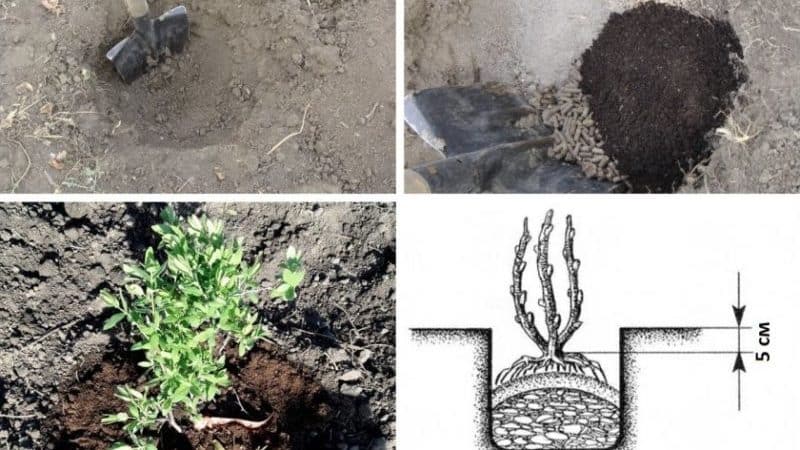
It is recommended to plant honeysuckle in early autumn. Heavy clay and light sandy soils are not suitable for the crop - better give preference to loamy or sandy loam mixtures. The depth of the planting hole is about 30 cm, the diameter is 50 cm.2 kg of overripe manure, 40 g of potassium and 60 g of phosphorus fertilizers are added to each pit. The seedling is placed in a hole, the roots are straightened and covered with earth. Plants are watered abundantly, mulched and sprinkled with compost soil.
Attention! The distance between bushes should be at least 2.5 m. If plants are planted more densely, berry picking and care become more difficult. Honeysuckle is located from south to north.
Water the crop 4-5 times per season, avoiding waterlogging. Fertilize three times: in early spring, in June and early October. The first feeding consists of 2 buckets of humus and 50 g of superphosphate; it ensures annual growth and bud formation. The second time, the mineral complex is added, the third time, 10–15 g of superphosphate and potassium salt. To protect against sawflies and spider mites, foliar feeding is organized: the bushes are sprayed with an infusion of tomato tops with tobacco and laundry soap.
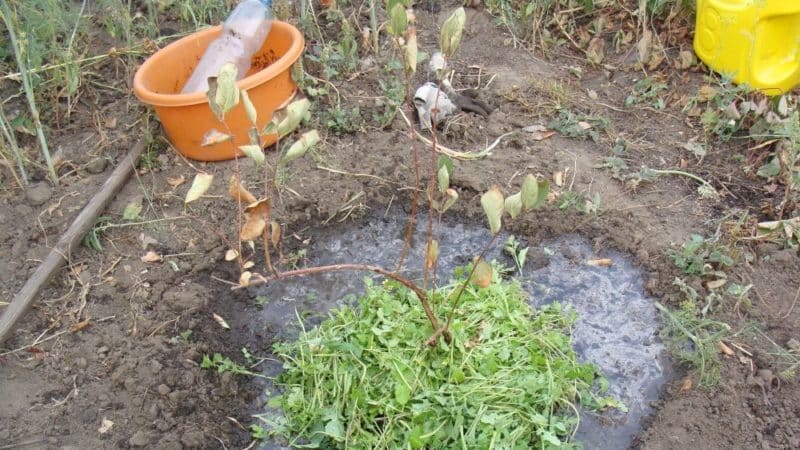
Beneficial features
Honeysuckle berries contain pectin, vitamins A and B, potassium, iron, phosphorus, and organic acids. The fruits have antioxidant properties, prevent capillary fragility and strengthen the immune system. Juice from fresh berries heals wounds, and the decoction has antimicrobial and anti-inflammatory properties. Eating honeysuckle improves the functioning of the gastrointestinal tract and normalizes metabolism.
A selection of the best varieties for Belarus
What should Belarusian honeysuckle be like? Some value berries for their size and weight, others for their taste and appearance. Let's consider the description of popular varieties.
Pitcher-shaped
Kuvshinovidnaya bushes are medium-sized with a compact crown and do not take up much space on the site. The shoots are thick and of medium length, the leaves are dark green. The berries are oval-cylindrical, pitcher-shaped, the average weight of the fruit is 1 g.The color is dark blue, with a thick waxy coating. The pulp is tender and juicy, the taste is sweet and sour. Pitcher-shaped ripens early, in early June. The berries do not fall off or crack, productivity is up to 1.5 kg per plant. The variety is valued for its unpretentiousness in cultivation, stable yield and strong immunity.
Titmouse
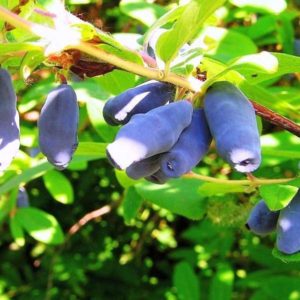
Bushes vigorous, with a rounded crown. The shoots are curved, medium thickness, the leaves are green, with strong pubescence. The base of the leaf is pointed, the flowers are light yellow. The weight of the berry is about 0.8 g, the shape is oblong-oval. The color is blue-yellow, hence the name of the variety. The skin is thin, with a waxy coating, the flesh is elastic and juicy. The taste is refreshing, sweet and sour, tasting score - 4.5 points. The ripening period is early, the fruits are used universally: jams, jams, and marshmallows are prepared from them.
Pavlovskaya

The ripening period is average, the harvest is harvested in mid-June. Fruiting is extended, the variety is early-bearing: it produces fruits 3 years after planting. The flowers are resistant to spring frosts, and the culture is unpretentious in care. The length of the oval berry is about 3 cm, the average weight is 1.2 g. The skin is thin, the flesh is dense, the taste is balanced sweet and sour, without bitterness.
Interesting! A convenient and quick way to prepare honeysuckle for the winter is to make a glaze. To prepare it you will need 1 tbsp. sugar, 1 tbsp. l. lemon juice and 1 egg white. The ingredients are ground together, as a result the mass thickens. The entire honeysuckle is dipped in the glaze and placed on a plate to dry. Then they are put into jars or containers.
Pavlovskaya They are valued for the transportability of the harvest; the berries do not spoil and retain their presentation. The shrubs are tall, about 1.4 m. The shoots are pubescent, the leaves are oval and light green.The variety is picky about the planting site, so it is recommended to plant it in well-lit areas.
Vasilyevskaya
The ripening period is early, the purpose is universal. The berries are oblong in shape, weigh about 1.5 g. The color is blue-violet, with a waxy coating, the skin is of medium thickness. The pulp is tender and juicy, the taste is harmonious sweet and sour. Vasilyevskaya is resistant to ticks, aphids and sawflies, and is rarely affected by diseases. Frost-resistant and unpretentious to grow. The shoots of the bush are erect, pubescent, up to 2 m high. Productivity is from 2 to 4.5 kg per season, depending on the age of the bush. For cultivation, it is advisable to buy two-year-old seedlings.
Bell
The ripening period is early, fruiting is extended. The variety is early-bearing and produces a harvest 3-4 years after planting. The shape of the berries is oval, weight - about 0.7 g. The color is blue-blue, with a waxy coating, the pulp is medium density, juicy. The taste is pleasant sweet and sour. The plant tolerates frosts down to -40°C, rarely gets sick, and is not attacked by insect pests.
Disadvantages - low drought resistance: due to lack of water, the pulp becomes bitter. The berries do not fall off after ripening and retain their presentation and taste. Honeysuckle is suitable for fresh consumption, processing and transportation.
Gourmand
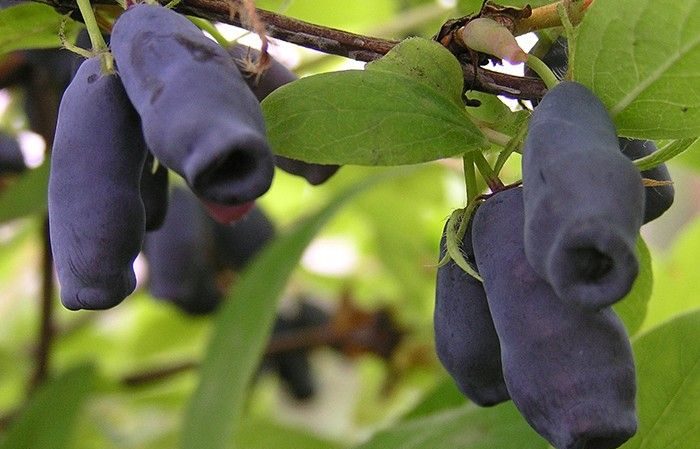
The height of the bush is about 1.3 m, the crown is oval. The foliage is dense, the shoots are thick and strong. The berries are oblong-oval, weigh 0.9 g, blue in color, with a waxy coating. The gourmet has tasty and tender flesh, no bitterness. Productivity is from 2.5 to 3 kg of fruit per season, the berries do not fall off. The fruiting period lasts from 6 to 20 years, the first harvest is harvested already 3 years after planting.
The seedlings quickly adapt to the climatic conditions of Belarus and do not freeze during spring frosts.To increase productivity near Gourmand pollinating varieties are planted: Blue spindle or Bluebird. The culture has an early ripening period and has a universal purpose.
Blue spindle
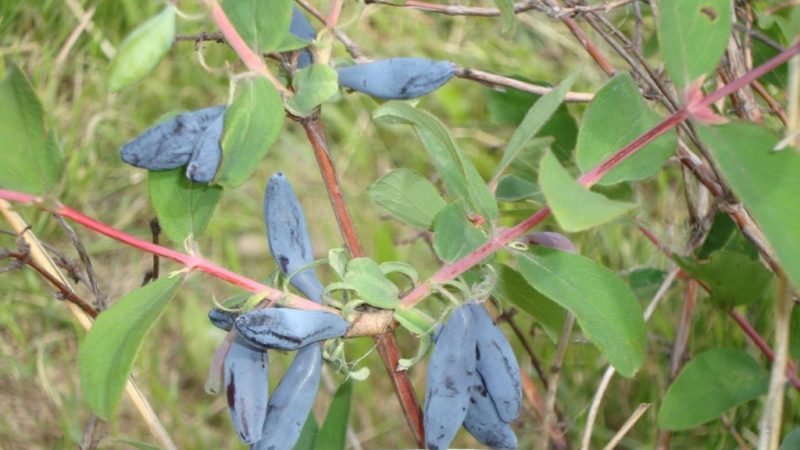
Bushes medium-sized and medium-compressed, suitable for planting as a hedge. The shoots are medium-sized, pubescent, the leaves are dark green oval. The berries are blue-black, with a waxy coating, the weight of the fruit is about 1 g. The skin is of medium density, the flesh is juicy and aromatic, sweet and sour, with a slight bitterness. Tasting score: 3.7 points. The advantages of the variety include immunity to diseases and pests, resistance to frost and drought, and versatility. Honeysuckle produces aromatic vitamin jam or jelly. The yield of the variety is up to 2.5 kg per plant per season.
Chosen One
Large-fruited honeysuckle Chosen is common not only in Belarus, but also in Russia and Ukraine. The shape of the berries is oval-elongated, the skin is thin, the color is rich blue, with a waxy coating. The taste is sweet and sour, not bitter. The flesh is elastic and tender, the aroma is pronounced. The ripening period is late, the fruits are harvested in July. The weight of the berry reaches 1.5 g, the yield per bush per season is 3.5 kg. The height of the bushes is up to 1.2 m, the crown is small, the leaves are light green. The harvest is suitable for transportation, storage and processing.
Altair
The bushes are low, the crown is rounded. The leaves are green, with slight pubescence, the shoots are strong. The berries are spindle-shaped, average weight - 0.9 g, color blue-blue. There is a thick waxy coating and a medium-density peel. The pulp is sweet and sour, harmonious, without bitterness. Altair's score is 4.4 points. The ripening period is average, the harvest is harvested in early July. Drought resistance is average, frost resistance is high.
Early varieties of honeysuckle for Belarus

Of the early varieties, gardeners distinguish honeysuckle Nimfa and Tomichka. Nymph's The bushes are medium-sized, the foliage is dense, the shoots are thin, slightly twisted. The berries are blue-blue, with a waxy coating, large, the weight of one reaches 3 g, length - 3 cm. The shape is oval-oblong, fusiform, the surface is lumpy. The taste is spicy, sweet and sour, with a slight bitterness. After ripening, the berries do not fall off; fruiting occurs in mid-June. The yield of the variety is up to 2 kg per plant.
U Tomsk residents The height of the bushes reaches 1 m, the leaves are light green, with pubescence. The bushes are beautiful and decorative. The berries are pitcher-shaped, the top is flattened, the tip is pointed. The color is blue-violet, with a waxy coating, the flesh is juicy, sweet and sour. The berries are suitable for processing: they are used to prepare syrups, confitures, and jams. Fresh Tomichka is also good.
Middle and late
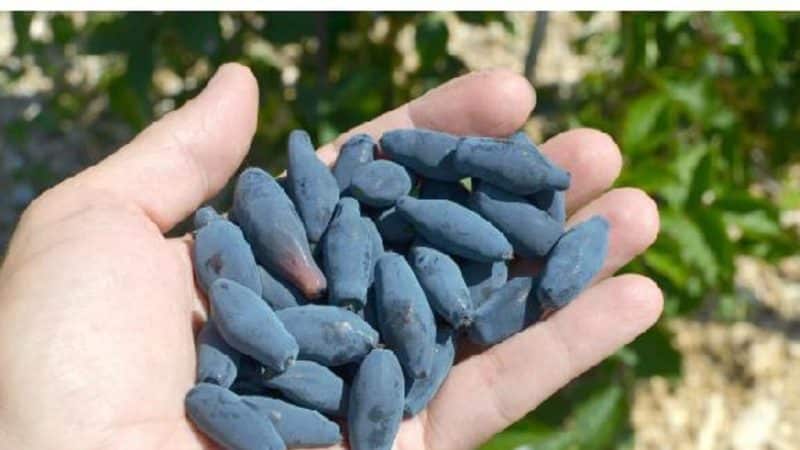
These varieties of honeysuckle are used mainly in cooking. Summer residents appreciate Malvina and Provincialka. Malvina - mid-season variety of dessert honeysuckle. Bushes up to 1.5 m high, the crown is oval and dense. The stems are thin, with slight pubescence, the leaves are dense, dark green. The berries are oval, slightly lumpy, blue-violet in color. The skin is strong, with a waxy coating, the flesh is sweet and tender. The taste is sweet, sour, the aroma is weak. Malvina rarely gets sick, bears fruit consistently - the bush produces up to 1.5 kg of ripe berries every year.
Provincial - a universal variety, unpretentious in cultivation. The shoots are curved and pubescent, the leaves are dark green. The berries are dark blue, oval, with a thick waxy coating. The peel is strong, the flesh is aromatic, the taste is sweet and sour. Tasting score - 5 points.Resistance to diseases, pests and frost is high.
Other options
In addition to the ripening time, gardeners pay attention to the size and taste of the fruits, and the ability of the varieties to self-pollinate. Sweet honeysuckle is grown for harvesting, and large-fruited honeysuckle is grown for sale.
The largest-fruited
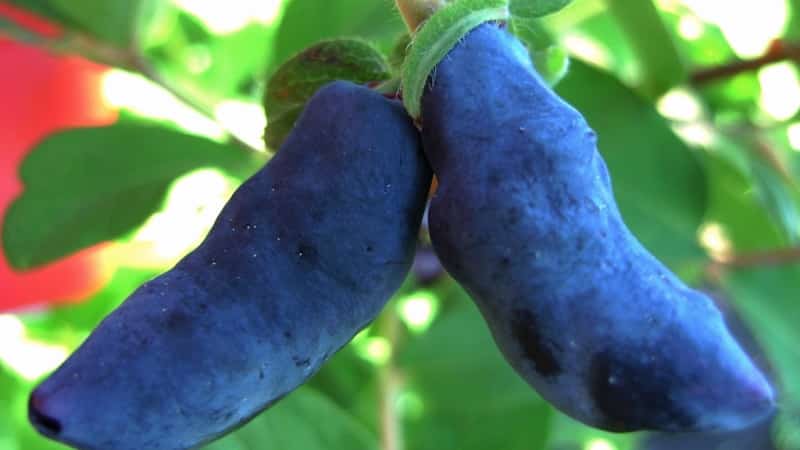
The largest-fruited honeysuckle varieties for Belarus are the Giant's Daughter and the Bakcharsky Giant. The average weight of the fruit varies from 1.5 g to 2 g, some specimens reach 3 g. The weight of the berries is influenced by the choice of planting site, the amount of fertilizer applied, and the composition of the soil. The Izanninitsa and Pavlovskaya are distinguished by their large sizes. These varieties are valued for their immunity to disease and resistance to shedding.
Self-pollinating
Most varieties of honeysuckle are not self-pollinating, so bushes of different varieties are planted next to each other for cross-pollination. Of the self-pollinating ones, only a few plants are distinguished - Yugan and Nymph. They do not require pollinating insects or other varieties and bear fruit consistently every year. This honeysuckle is unpretentious to grow and is suitable for novice gardeners.
The sweetest
A characteristic feature of some varieties is bitterness in the pulp. It is for this reason that honeysuckle is not as common as cherries or raspberries. However, there are varieties with sweet-sour pulp, without bitterness. For example, Nekrasovka, Cinderella, Violet. The berries are distinguished by their delicate and pleasant pulp and delicate aroma. They are good fresh and processed.

Advice! It is recommended to grind bitter honeysuckle with sugar or cook compote. Some housewives freeze the fruits for the winter - then add them to ice cream, teas, and desserts.
How to choose a variety

Gardeners recommend paying attention to the ripening period: early plants produce a harvest in early summer, medium ones - at the end of June, late ones - in July. To make jam, berries with a sour and tart flavor are used; for fresh consumption, sweet fruits with tender and aromatic pulp are used.
Large-fruited honeysuckle with a strong peel and a thick waxy coating is grown for sale: it protects the berries from spoilage and cracking. It is advisable to take a closer look at self-fertile varieties: they bear fruit consistently. Frost-resistant honeysuckle is also in demand. You can find out more information about the variety from reviews and photos of experienced gardeners in the Republic of Belarus.
Conclusion
The climate and soils of Belarus are ideal for planting and growing honeysuckle. Popular varieties: Sinichka, Kolokolchik, Pavlovskaya, Vasilievskaya - they are distinguished by large and tasty fruits, immunity to diseases and pests, stable yields and frost resistance. Honeysuckle is planted on sandy or loamy soils, a hole is dug 30 cm deep and 50 cm in diameter. Care consists of watering, root and foliar feeding, removing weeds and loosening the beds. Many varieties decorate the garden plot: the bushes attract with yellow, white, and red flowers.